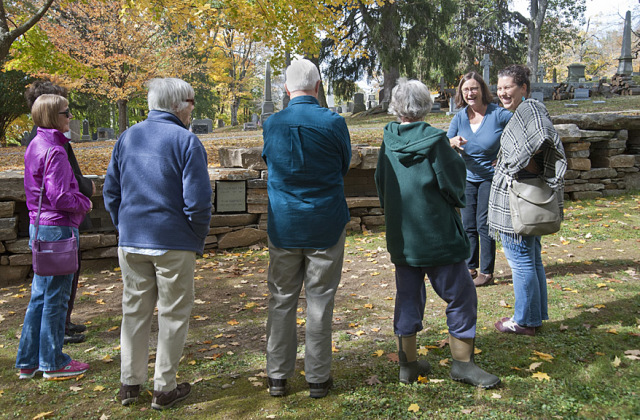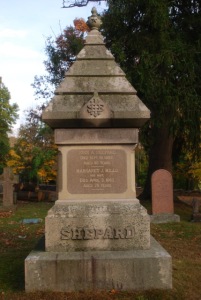Center Cemetery: A Walk Through Time
New Columbarium Almost Finished
By Lindsey Pizzica Rotolo
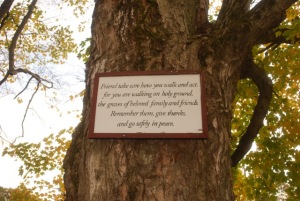 At the entrance to Center Cemetery off of Old Colony Road, a wood sign affixed to a towering maple tree invites “friends” to “take care how you walk and act, for you are walking on holy ground, the graves of beloved family and friends. Remember them, give thanks and go safely in peace.” It sets the tone for reverence, which is exactly what Center Cemetery demands.
At the entrance to Center Cemetery off of Old Colony Road, a wood sign affixed to a towering maple tree invites “friends” to “take care how you walk and act, for you are walking on holy ground, the graves of beloved family and friends. Remember them, give thanks and go safely in peace.” It sets the tone for reverence, which is exactly what Center Cemetery demands.
When you walk through its grounds, the natural beauty of the place shines out through the tranquility. Some of the largest and most glorious maples, oaks and pines in town can be found in Center Cemetery, and a few sections of the property have extensive patches of thick, sumptuous moss that are hard to believe arrived there only by Mother Nature’s will.
Many headstones contain the names of Norfolk notables, while others are simply marked with a number. The Eldridge family has the preeminent section of the cemetery, a large plot on high ground containing a huge raised tomb for Sarah Battell and Joseph Eldridge, flanked by ornately carved stone Celtic crosses marking Sarah and Isabella Eldridge’s final resting spots.
The cemetery’s maintenance staff, Jessica Belcourt and Rose Whitford (whose great grandparents are buried there), have their “favorite” gravestones, those marking the grave of Martha Allen, a 2-year-old who died in 1784 from the “bite of a mad cat,” and the grave of J. H. P. Stevens, M.D., whose polished memorial somehow weathered to produce a large heart shape covering over half the width of the slab.
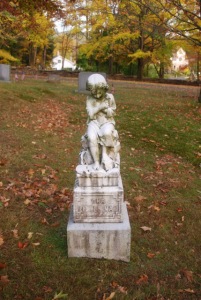 Set high above the Blackberry River, Center Cemetery was originally a one-acre lot established in 1757. Additional acreage was added in 1774 and 1796 from Giles and Daniel Pettibone, respectively. E. Grove Lawrence added more land to the parcel in 1878. There were lawsuits from 1860 to 1881 between the Stevens family (who owned the land and still-existing home across the street from the cemetery), the town and the Battell family, but the town still managed to continuously own and operate the cemetery until 1906 when the Cemetery Association was incorporated.
Set high above the Blackberry River, Center Cemetery was originally a one-acre lot established in 1757. Additional acreage was added in 1774 and 1796 from Giles and Daniel Pettibone, respectively. E. Grove Lawrence added more land to the parcel in 1878. There were lawsuits from 1860 to 1881 between the Stevens family (who owned the land and still-existing home across the street from the cemetery), the town and the Battell family, but the town still managed to continuously own and operate the cemetery until 1906 when the Cemetery Association was incorporated.
The original members of the association were a veritable “who’s who” of Norfolk’s most civic-minded citizens: Battell Stoeckel, Bridgman, Brown, Clark, Cowles, Crissey, Scoville, Selden and Spaulding, as is today’s association, which is made up of Susan Anderson, Bruce Anderson, Madeleine and Richard Byrne, Hope Childs, Holly Gill, Chuck Gillett, Leila Javitch, Karen Linden, Hartley Mead and Bill Millard.
While the association was technically the sole agent of cemetery functions, it was more often treated in the first half of the twentieth century as the mere manager of the grounds, prompting Edwin Winter Mead to make the distinction official at a town meeting in the fall of 1947. At a special town meeting in 1974, the land, buildings and improvements were quitclaimed to the Norfolk Center Cemetery Association, finally freeing the association from any town involvement.
 In the 40 years since that quitclaim, the association has been considering some kind of special development for section 9 of the “new” section of the property. A couple of years ago, Pete Anderson drew up a concept sketch for a columbarium (a place for urns holding cremated remains), and the association hired Robin Key Landscape Architecture (RKLA), based in Manhattan, to turn Anderson’s concept into a fully realized installation.
In the 40 years since that quitclaim, the association has been considering some kind of special development for section 9 of the “new” section of the property. A couple of years ago, Pete Anderson drew up a concept sketch for a columbarium (a place for urns holding cremated remains), and the association hired Robin Key Landscape Architecture (RKLA), based in Manhattan, to turn Anderson’s concept into a fully realized installation.
RKLA suggested Dan Snow for the construction of the stone wall design. A Vermonter with 38 years of nationally highlighted experience building dry stone creations, Snow was quickly approved for the job. Slightly serpentine in form, the 100-foot-long wall stretches across a formerly empty stretch of land on the east side of the cemetery, and took Snow only two months to complete.
Robin Key designed the openings for the placements on the east side of the wall, so visitors would be forced to view the cemetery from its best angle (looking out over the cemetery to the west). Anchored between two maples and two impressive oaks, the columbarium has 50 niches that can accommodate up to two urns in each recess.
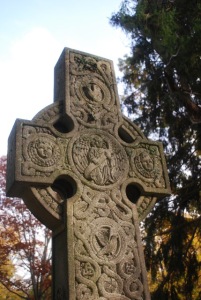 The urns will be housed in stainless steel boxes constructed by Architarium, a company from Austin, Texas. More locally, Kingsland Company will position the boxes, and John Bascetta will do the engraving on the bluestone markers that will cover each niche.
The urns will be housed in stainless steel boxes constructed by Architarium, a company from Austin, Texas. More locally, Kingsland Company will position the boxes, and John Bascetta will do the engraving on the bluestone markers that will cover each niche.
Time spent at Center Cemetery is a history lesson, as well as a narrative of each of our lives. Reading the headstones in the newer section of the cemetery transports you to a time when those now gone were here, with us. It is impossible not to reflect on them, their impact on us as individuals and on our community as a whole.
If you’ve never had occasion to visit Center Cemetery, now is a great time to “remember . . . , give thanks and go safely in peace.”
For more information on RKLA and Dan Snow, go to www.rklastudio.com and www.dansnowstoneworks.com.
Photo (top) by Bruce Frisch: Landscape designer Robin Key discusses the final stage of the columbarium project with members of the Cemetery Association.
All other photos by Lindsey Pizzica Rotolo.
